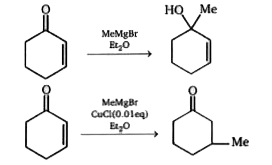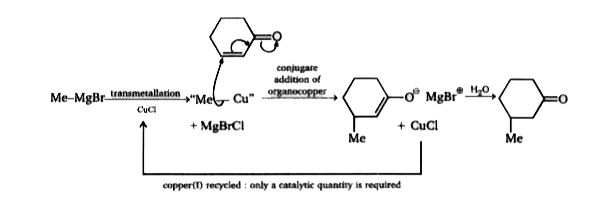In the reaction sequence :

A

B

C

D

Text Solution
The correct Answer is:B
Copper (1) salts have a remarkable effect on organometallic reagents. Grignard reagents add directly to the carbonyl group of a, B-unsaturated aldehydes and ketones to give allylic alcohols : you have seen several examples of this, and you can now explain it by saying that the hard Grignard reagent prefers to attack the harder C=O rather than the softer C=C ectrophilic centre. Here is a further example - the addition of MeMgBr to a cyclic ketone to give an allylic alcohol, plus, as it happens, some of a diene that arises from this alcohol by loss of water (dehydration). Below this example is the same reaction to which a very small amount (just 0.01 equivalents, that is 1%) of copper(I) chloride has been added. The effect of the copper is dramatic : it makes the Grignard reagent undergo conjugate addition, with only a trace of the diene.

Organocopper reagents undergo conjugate addition:
The copper works by transmetallating the Grignard reagent to give an organocopper reagent. Organocoppers are softer than Grignard reagents, and add in a conjugate fashion to the softer C=C double bond. Once the organocopper had added, the copper salt is available to transmetallate some more Grignard, and only a catalytic amount is required.

|
Updated on:21/07/2023
Similar Questions
The product (B) of the reaction sequence is:
 View Solution
View SolutionThe end product (B) of the reaction sequence
 is .View Solution
is .View SolutionThe end product (B) of the reaction sequence
 .View Solution
.View SolutionWhat is the product of the reaction sequence?
 View Solution
View SolutionWhat is the product of the reaction sequence?
 View Solution
View SolutionConsider the reaction sequence below :
 View Solution
View SolutionConsider the reaction sequence below:
_E01_318_Q01.png) View Solution
View SolutionConsider the reaction sequence below :
 View Solution
View SolutionConsider the reaction sequence below:
_E01_318_Q01.png) View Solution
View SolutionConsider the following reaction sequence. The final product of this reaction sequence is
 View Solution
View Solution

